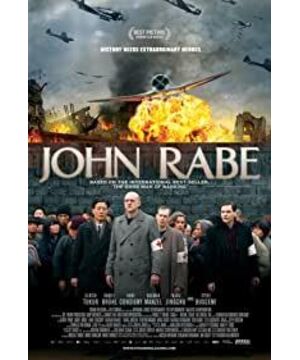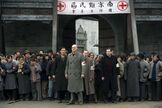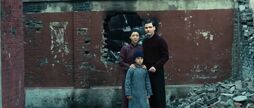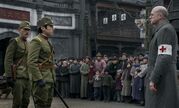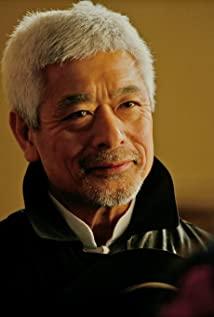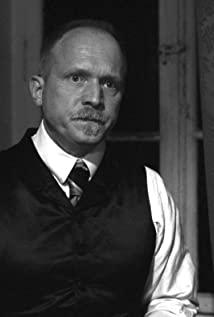Rabe’s Tomb is located in the Wilhelm Memorial Church Cemetery in the western suburbs of Berlin. This cemetery is more famous in the local area. Most of the burials are the members of the memorial church, and there are also celebrities like the violin master Joseph Joachim and the founder of European personality rights law Otto Kirk.
Entering the cemetery, the reporter happened to run into Stetz, the cemetery cleaner. He heard that I was Chinese and said with a smile, "I know who you are looking for." After that, he threw down the tools in his hand and took me to the depths of the cemetery. On the way, Stetz told reporters that there have been particularly many Asians who have come here recently.
When Stetz took me to the "BWB" area and pointed to a small piece of green grass surrounded by cement strips under a big tree, I was a little stunned. No tombstones, no statues, let alone epitaphs, is this the Rabe cemetery? But a small wooden sign on the grass clearly read: John Rabe, 1882.11.23—1950.01.05. Stetz said that this small wooden sign was erected not long ago. Rabe is buried on the right side of the cemetery, and Mrs. Rabe is buried on the left.
It turned out that Rabe was buried here after his death in 1950. In 1985, because the lease of the cemetery had expired and no one renewed the contract, the management department removed the tombstone. Since then, there has been no sign in the cemetery. In 1997, Rabe’s tombstone was removed from his children’s home and transferred to the Holocaust Memorial in Nanjing through the Chinese Embassy. As the cemetery in Berlin has been unrecognizable, even Rabe’s granddaughter had gone the wrong way and took visitors to other places.
The
manager of the cemetery who did not obtain the title of "historical celebrities" told reporters that in the late 1990s, Nanjing had repeatedly hoped that Berlin would grant the Rabe cemetery the "honorary cemetery" qualification, but it was rejected by Berlin. The reason for the Berlin city government is that the lease of this cemetery was broken from 1985 to 2005. However, people familiar with the situation disclosed that, in fact, the financially distressed city government did not want to pay for this cemetery. In this way, the Rabe cemetery does not belong to the "tomb of historical celebrities", nor does it have the right to erect monuments for free forever. At present, Nanjing City has promised to pay the cost of Rabe Cemetery for 20 years. In October of this year, Nanjing will present a bronze bust and base of Rabe to Berlin.
Compared with the Rabe cemetery, one can find a complete "Rabe image" in the Rabe Private Museum in Heidelberg, Germany. This small museum was opened by Rabe’s grandson Thomas Rabe. Surrounded by flowers and green trees, a bronze bust of Rabe stands in the courtyard of the museum. The reporter saw that the four characters "Nanjing Good Man" were engraved on the base of the statue, and a cement-made "Rabe's Diary" was erected underneath. A place of cobblestones symbolizes the many victims of the Nanjing Massacre. This statue was donated by Chinese students studying in Germany in order to arouse more people's memory of history. The museum displays more than 20 books written by Ben Rabe, as well as precious documents and historical materials such as real objects and newspaper clippings. What attracted the attention of reporters most was the original handprint of the 602 Nanjing citizens who had been protected by Rabe.
In the
early years of the rise of "Raberger" in Germany , Rabe's status as a member of the Nazi party made Germans quite taboo, let alone donated money to build a statue. More than ten years ago, the German version of Rabe's Diary, which had a small circulation, did not attract the attention of the German people. However, the release of the film "Rabe's Diary" in Germany triggered Rabe fever.
Recently, the number of local Germans visiting the Rabe cemetery and museum began to increase. The reporter saw in the Graf Berlin Bookstore, Germany's largest bookstore chain, that the store opened a small booth for Rabe Books. "John Rabe" written by Irwin Weiketz also appeared on the "Spiegel" weekly "Bestseller" list. In addition to books, Rabe statues and Rabe DVDs were also sold on the booth. A customer told reporters, “I only knew Auschwitz before, but now I know Nanjing.”
Rabe’s film also attracted academic attention. The history of the Nanjing Massacre has become a new theme for some East Asian institutes in Germany. Rabe’s hometown, Hamburg, known as the "Han Fort", is also planning to erect a monument to Rabe. It is no wonder that experts on German-Chinese issues believe that Rabe has become the "ambassador of friendship" between Germany and China.
View more about John Rabe reviews


